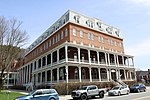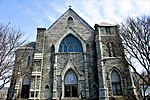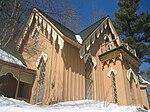Vermont State House

The Vermont State House, located in Montpelier, is the state capitol of the U.S. state of Vermont. It is the seat of the Vermont General Assembly. The current Greek Revival structure is the third building on the same site to be used as the State House. Designed by Thomas Silloway in 1857 and 1858, it was occupied in 1859. A careful restoration of the Vermont State House began in the early 1980s led by curator David Schütz and the Friends of the Vermont State House, a citizens' advisory committee. The general style of the building is Neoclassical and Greek Revival and is furnished in American Empire, Renaissance Revival, and Rococo Revival styles. Some rooms have been restored to represent latter-19th-century styles including the "Aesthetic Movement" style. Since 1994, Buildings and General Services Architect Tricia Harper has been responsible for design and construction for the restoration and renovation project of the building and its grounds. The Vermont State House is located on State Street on the western edge of downtown Montpelier, a block north of the Winooski River. Set against a wooded hillside (which was open pasture land earlier during much of its history), the building and its distinctive gold leaf dome are easily visible while approaching Montpelier, the smallest city to serve as capital of a U.S. state.
Excerpt from the Wikipedia article Vermont State House (License: CC BY-SA 3.0, Authors, Images).Vermont State House
State Street, Montpelier
Geographical coordinates (GPS) Address Website External links Nearby Places Show on map
Geographical coordinates (GPS)
| Latitude | Longitude |
|---|---|
| N 44.2625 ° | E -72.580555555556 ° |
Address
Vermont State Capitol (Vermont State House)
State Street 115
05602 Montpelier
Vermont, United States
Open on Google Maps







